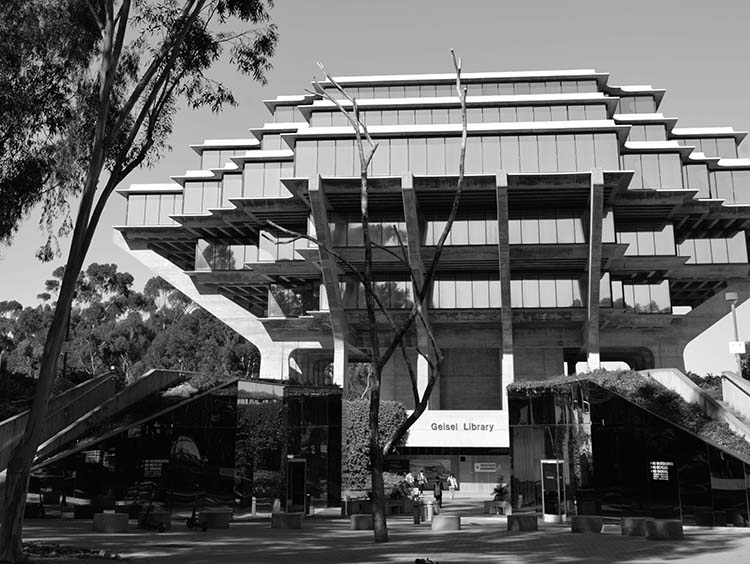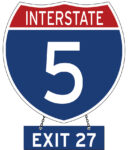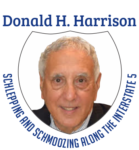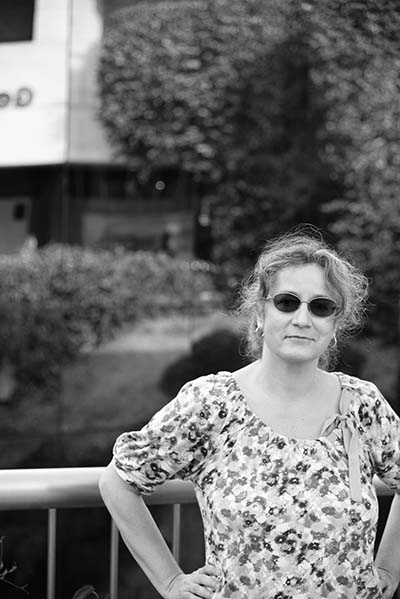
 Editor’s Note: This is the 12th chapter in Volume 2 of Editor Emeritus Donald H. Harrison’s 2022 trilogy: “Schlepping and Schmoozing Along the Interstate 5.” All three books may be purchased from Amazon.com. Harrison may be contacted via donald.harrison@sdjewishworld.com
Editor’s Note: This is the 12th chapter in Volume 2 of Editor Emeritus Donald H. Harrison’s 2022 trilogy: “Schlepping and Schmoozing Along the Interstate 5.” All three books may be purchased from Amazon.com. Harrison may be contacted via donald.harrison@sdjewishworld.com
Schlepping and Schmoozing Along the Interstate 5, Exit 27 (Gilman Drive): UCSD Holocaust Living History Workshop
From northbound Interstate 5, take the Gilman Drive exit, turn left and follow to the UC San Diego campus. Its central address is 9500 Gilman Drive.
 LA JOLLA, California — The Geisel Library at the University of California San Diego is named for Theodore Geisel, who wrote children’s books under the pen name “Dr. Seuss.” It leased from the Shoah Foundation access to 55,000 digitized interviews with Holocaust survivors from all over the world. Next, it embarked on a program to make students, faculty, staff and visitors aware of this important resource that was financed by film producer Steven Spielberg.
LA JOLLA, California — The Geisel Library at the University of California San Diego is named for Theodore Geisel, who wrote children’s books under the pen name “Dr. Seuss.” It leased from the Shoah Foundation access to 55,000 digitized interviews with Holocaust survivors from all over the world. Next, it embarked on a program to make students, faculty, staff and visitors aware of this important resource that was financed by film producer Steven Spielberg.
Spielberg established the Shoah Foundation, which has headquarters in Los Angeles at the University of Southern California, after making the impactful Holocaust movie Schindler’s List. UC San Diego’s former head librarian Brian Schottlaender, consulting with History Prof. Deborah Hertz, decided during the 2006-2007 academic year to lease the database and to make it available for free to anyone on campus.

Susanne Hillman, a Swiss-born student of the Holocaust, today teaches Modern European History across town at San Diego State University, while continuing to work as the coordinator of UCSD’s Holocaust Living History Workshop. She began her workshop job in 2010 while conducting research for her doctoral dissertation on Margarete Susman, a German Jewish poet and philosopher who found refuge from the Nazis in Switzerland.
At the workshop’s coordinator, Hillman taught people how to navigate their way through the indexed archives, which are a treasure trove for anyone interested in European Jewish life before, during, and after the Holocaust. The way the Shoah Foundation interviews were conducted, the survivors spoke about their families and their neighborhoods or towns prior to the Holocaust, what happened to them during the Holocaust, and their experiences after the Holocaust. These interviews were approximately two hours long, on the average. So imagine you are interested in a specific town in Europe—for example, Roudnice, Czech Republic, origin of the Holocaust Torah owned by Congregation Beth Am of San Diego. You could use “Roudnice” as a search term and find all the ways it was described by the interviewees.
As valuable as the massive database is, Hillman said relatively few people on campus utilized it, prompting Schottlaender and Hertz to direct Hillman’s efforts toward creating on campus the Holocaust Living History Workshop at which periodic lectures about the Holocaust were presented in the Seuss Room. Initially, local Survivors of the Holocaust gave their testimonies and engaged in question-and-answer sessions with audiences. Attendance averaged 100 per lecture after that programming was expanded to include children of Survivors (known as the Second Generation) and scholars drawn from local, national, and international universities and research centers. The presentations, typically occurring once a month during the academic year, were videotaped and made available for research through the library’s digital collections platform.
Hillman said she particularly enjoys the question-and-answer sessions when quite often “we have some really marvelous discussions, where people learn to think of things in new ways.”
The program has attracted its share of donors who believe—as Hillman does—that the Holocaust has many lessons to teach, including “how can a modern civilized society begin this onslaught on human life—that has not been solved.” Furthermore, she said Holocaust discussions can be springboards to other issues involving questions about race, migration, refugees, and genocide.
Donors include Estelle Dunst, widow of Holocaust survivor and author Lou Dunst; Danny and Phyllis Epstein, Lorraine Ratner (who was an interviewer for the Shoah Foundation’s Visual History Archive); Judi Gottschalk, daughter of Holocaust Survivor Agathe Ehrenfried; and July Galper, who arranges San Diego recitals for Israeli artists under the auspices of the American Israeli Cultural Foundation.
Having grown up in German-speaking Switzerland, in a small town near Bern, Hillman has given considerable thought to the role that her neutral country played during the Holocaust. Switzerland was a refuge for some German Jews, including poet Susman, who immigrated in 1933 but it turned away most other Jews fleeing the Nazis. Susman won admittance to Switzerland as a “political refugee” prior to the time that Nazi Germany, at Switzerland’s request, added a “J” to passports held by Jews.
“I try to be objective and look at the issue from all angles,” she told me. “Switzerland was in a difficult position. If you look at the map, to its north is Germany; to the east Austria; to the west France, which was occupied, and to the south Italy. So, it was encircled. So, the real threat did lead some people and especially the police chief [Heinrich] Rothmund to adopt a very stringent policy against refugees and I deplore it wholeheartedly.”
“The border was essentially completely sealed at the times when Jews in Germany or Austria were in greatest distress,” Hillman continued. “This was not a policy that the population adopted; the population had no say. On the other hand, there were Swiss who were happy keeping people out. The sad fact is from 1933 to 1938, very few refugees were able to settle in Switzerland, only a couple hundred, I would say.”
“You needed to prove that you could support yourself financially and also that you were a political refugee,” Hillman went on to explain. “Even though many Jews had to flee because they were Jews, that didn’t matter to Swiss authorities. So, I think it was a stain on Swiss history that Jews were prevented form entering the country. Only later in the war, about 25,000 were able to attain safety, but an equal number were turned away and as a result were killed. I really wish that hadn’t been the case.”
*
Donald H. Harrison is editor emeritus of San Diego Jewish World. He may be contacted via donald.harrison@sdjewishworld.com